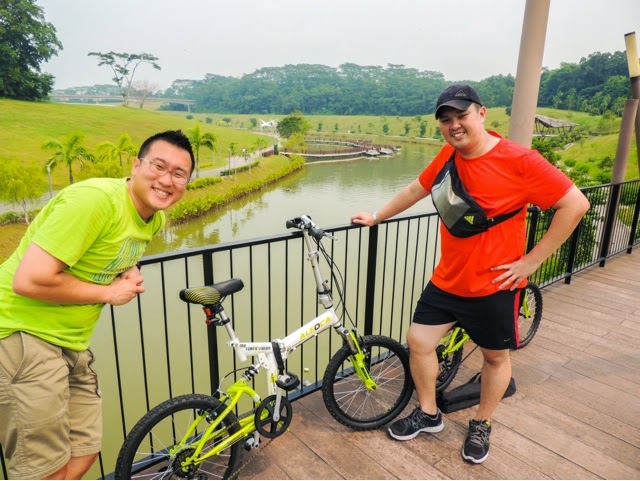I thought it was necessary to explain why this entry features two married men more than anybody else, hence the rambling background below. Earlier in the year, some of us came together to establish a couples group, to encourage each other along this heavenward road. One day we agreed to go on day trips to Malaysia. After two grueling day trips (the early starts, the long drives and the uphill walking), it began to seem like it was all the men's bad idea. So we decided to come together this time round, at Allan and Cindy's place in Punggol, for a less exacting exertion - steamboat and tiramisu. As the ladies busied themselves, Allan and I decided to go for a ride along the area's scenic waterways. We created a partial glossary out of our Punggol encounters. Forgive the pun.
Anglers in our well-ordered city live in a world of contradictions. They disregard the concrete markers laid down to separate land claimed from land yet unclaimed. But at the same time they also swear by the planar certainty of water's edge, where their life's purpose hangs by a nylon thread. We saw a determined handful, occupying different ecological niches in a classic demonstration of evolutionary radiation - two beyond spiked railings standing at the edge of the concrete embankment facing Pulau Serangoon, three in relatively more commodious conditions chatting happily away on a shaded bench, their fishing rods secured to the adjacent rails and a lone angler standing shin-deep along a creek, casting and reeling and casting and reeling in clockwork stolidity.
2. Birds
The Punggol-Serangoon Reservoir Scheme and the Punggol Waterway Park are both valiant attempts to reconcile the conflicting prerogatives of conservation and development. The result? Superb bird-watching opportunities practically at one's door-step. Alas, we lacked that treasured quality of many accomplished birders - patience. Furthermore, we were on wheels, and movement is the very antithesis of the elusive stillness that patience must necessarily embrace. In our hurry, we still managed to bag a few uncommon avian sights - a long-tailed shrike, a coot and some terns. We don't have photographs of the latter two, for the glimpses of the coot were too fleeting and the terns never stopped flying.
Above: the Pacific swallow is one of the fastest flyers in our skies. I was very lucky to have discovered how this individual liked to return to this particular perch. All I had to do after that was to wait and keep my hands steady.
Below: "looks like some kind of shrike," was Jayson's guess when he saw this photograph. It was - a long-tailed shrike, to be precise. It looks like another pleasant songbird, but it is known to feed kebab-style after impaling its prey - bees, lizards, rodents - on small branches.
3. Construction
Yes, I am saddened by this unceasing war against the forest. No, I am not about to launch into another diatribe against development. (Or have I already?) But Nature has not been banished entirely in Punggol. This isn't a hunt. It is domestication. Nature has been pruned, trimmed and rehoused. In fact, one of Punggol's attractions is how appealingly this has been achieved, even as groves of high-rises, steel and cement daffodils and daisies in our eternal Singaporean summer, swallow a receding horizon. The waterway, which bisects Punggol, then becomes a green-gold filament stitching together the living canvas of both built and born.
Below (from top to bottom): another canalized waterway, another familiar skyline; the Serangoon Tidal Gates, which regulates the water level in yet another of our estuarine reservoir and prevents sea water coming in.
4. Denizens other, reptilian
Well, monitors and terrapins do not excite as much as coloured feathers. They don't exactly move as effortlessly and gracefully as birds seem to do either, each step forward a heaving, laboured lumber. But it is always a delight to spot wild scales that do not belong to geckos darting across faded paint. And monitors actually move rather gracefully through water.
Below: A familiar local versus foreigner face-off, in another guise? The terrapin is actually North American in origins, but have multiplied in local waters owing to their adaptability, and the speed with which they outgrow their tanks and owners' affection. In any case, the reptilian rumble for which we were holding our breaths never materialized.
5. Exercise enthusiasts
One of Mary's ex-colleagues once remarked that Punggol would be a good place to raise children because of its wide, open spaces. Neither heat nor haze at noon prevented both locals and expatriates - from seasoned cyclists to children in outsized helmets on garrishly-coloured bicycles, bronzed runners to reddened amateurs - from coming out and enjoying themselves.
Above: We didn't have time to cross the bridge to the Lorong Halus Wetlands and turned back towards lunch shortly after this photograph was taken. Allan looked happy, but he was in fact rather unhappy with the bicycle seat. Mary later suggested tying a pillow to the seat. This only succeeded in sparking a little, inconclusive debate on whether it would have been better to tie it to the buttocks rather than the seat.
6. Fellowship
Gatherings in Punggols look set to become a commoner prospect in the coming years, as the people of our generation move in to build their own families. But in this case, beyond the unseen hand of demographics, we have Allan and Cindy's boundless generosity to thank - coming out early in the morning to stock up for the afternoon feast, giving us a ride to Punggol (and back to Ang Mo Kio later on) and providing us with a home away from home. Because of them, we no longer speak of Punggol in the abstract - as an offhand metaphor for remoteness, tiny flat complaints, congested LRTs and once upon a time pig farms.
Above: satisfied faces after lunch. My food hasn't arrived yet.













No comments:
Post a Comment